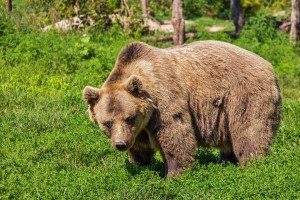The last thing that anyone wants to encounter in the wilderness is a surprised or angry bear. Unfortunately, as habitat continues to decrease due to deforestation, human and bear encounters become more likely, and the risk of encountering a bear increases when hunters, hikers or Trailblazers enter into the bear’s natural habitat. Unfortunately, for a hiker or survivalist to encounter a bear in the wild typically means that they are indeed involved in a life or death situation, and there is no time to waste. Actions must be effective, and there is no time to scramble or be indecisive.
The first thing that needs to happen when someone encounters a bear is to identify quickly what type of bear you’ve stumbled across. Not all bears are equal, and their species will dictate their typical behavior patterns and how best to counter them. While bears can typically be identified simply from location, several species of bear can exist in similar areas, and knowing how to tell the difference is critically important and directly related to the chances of survival.
Black Bears are smaller than their grizzly cousins and typically weigh between 125 and 660 pounds, depending on gender and age. Grizzly bears are much larger and weigh between 660 and 1500 pounds. Both of these bears are common in North America. While these bears are both found in North America, their temperament and behaviors vary and being able to distinguish the differences can be a matter of life and death.
Types of bears that you can encounter in the wild
Black Bears
When a Black bear feels threatened, it will attempt to defend itself vigorously. It will primarily attempt to strike or swat at what it deems to be a threat and may attempt biting. It will not, however, immediately go for the throat or head region, which would define an attempt to kill. When a Black Bear launches a predatory attack, however, they may stalk humans as prey. Attempts to bite the top of the head or the neck are common and are likely to attempt to control their prey by grabbing it while biting. A predatory black bear will not stop in the attack and is tenacious.
Grizzly Bears
 When a Grizzly bear feels threatened, there are several possible scenarios. The bear may attempt to flee from a situation in which they feel threatened, or they may try a false charge to test whether or not you are a genuine threat. Examining the ear position of an attacking grizzly can lend vital clues to the attack’s intent. Ears that are sloping back towards the rear of the animal are far more vicious and dangerous. Also, watch for tell-tale body language, which may include growling and raised hair on the back or neck. Attacking Grizzly bears will go to the top of the head, or aim for the back with a powerful and deadly paw swat. A predatory grizzly that intends to attack an object deemed as prey will increase the intensity, and may stand its ground rather than charge. The likelihood of swats and attempted bites will also increase. A bear who is on all four legs will also sway from side to side and open/close its jaws as a show of force.
When a Grizzly bear feels threatened, there are several possible scenarios. The bear may attempt to flee from a situation in which they feel threatened, or they may try a false charge to test whether or not you are a genuine threat. Examining the ear position of an attacking grizzly can lend vital clues to the attack’s intent. Ears that are sloping back towards the rear of the animal are far more vicious and dangerous. Also, watch for tell-tale body language, which may include growling and raised hair on the back or neck. Attacking Grizzly bears will go to the top of the head, or aim for the back with a powerful and deadly paw swat. A predatory grizzly that intends to attack an object deemed as prey will increase the intensity, and may stand its ground rather than charge. The likelihood of swats and attempted bites will also increase. A bear who is on all four legs will also sway from side to side and open/close its jaws as a show of force.
Survival tips
Defending yourself successfully against an attack is a time-sensitive venture. Do not run or act in ways that may portray you as prey to an already-predatory animal. Fight back with everything you have, and stay calm. Expand your body by holding your arms out and spreading your legs more widely. This makes you appear bigger than you are. Don’t make eye contact, but pay close attention to the bear’s actions. Noise may or may not help, but there have been instances of metallic sounds scaring away bears. Don’t make any sudden movements. Since most bears are excellent climbers, attempting to climb a tree to escape is not recommended, but putting a large object like a tree or a rock between yourself and the bear is a good buffer zone between your body and a potential attack.
The best survival advise possible is to do your best to remain calm and not to run away. Decisions have to be made within seconds to give you the best possible chance of survival. Further investigation and study increase your chances of survival exponentially, and the more you know, the more likely you are to fend off a hostile animal encounter.
